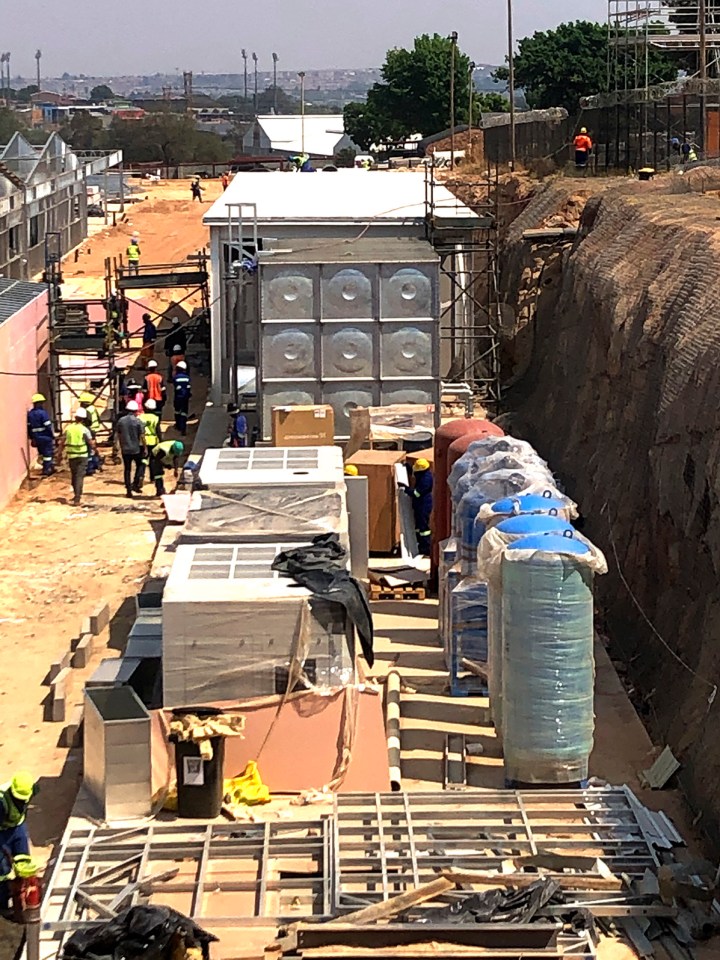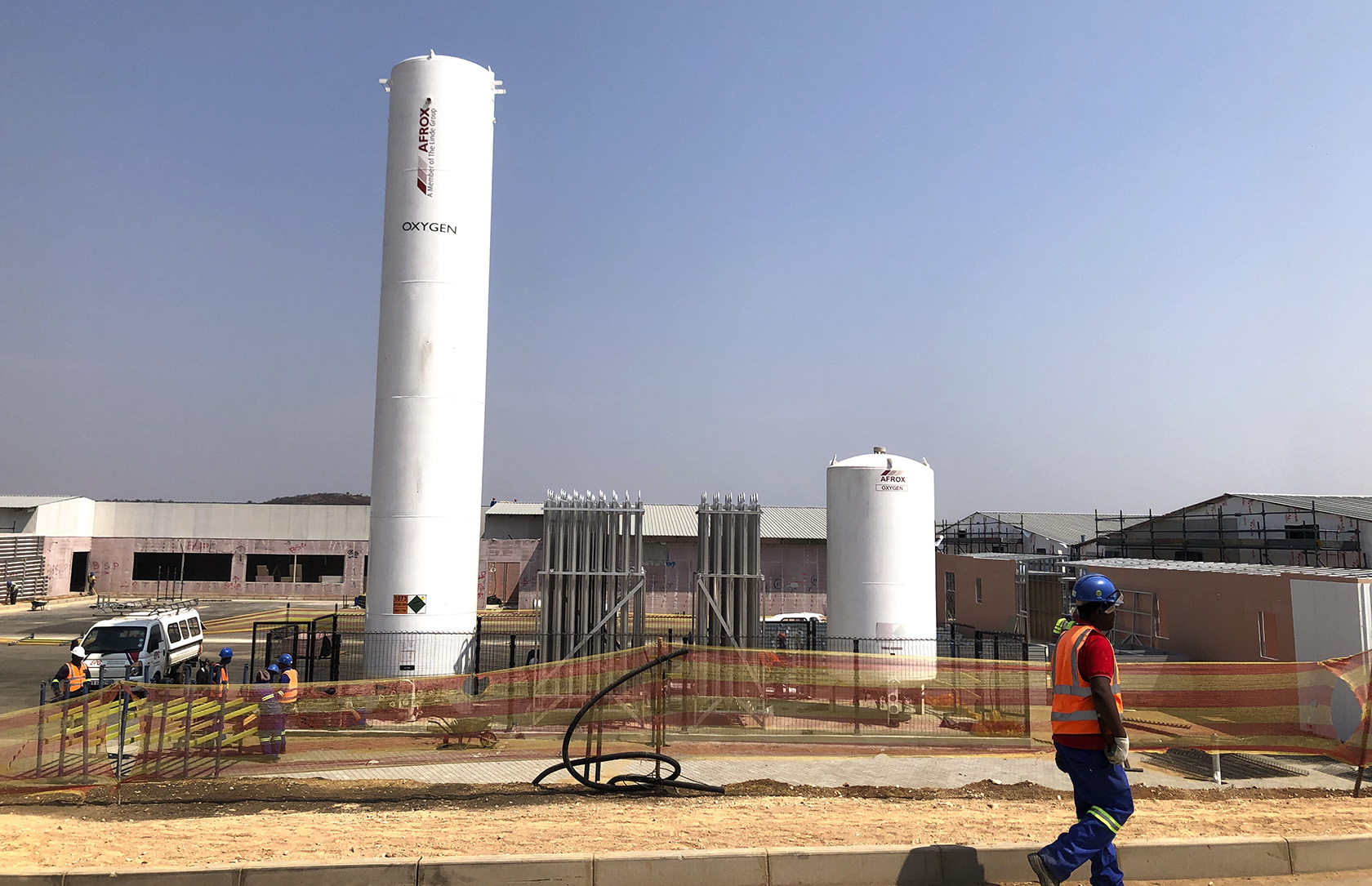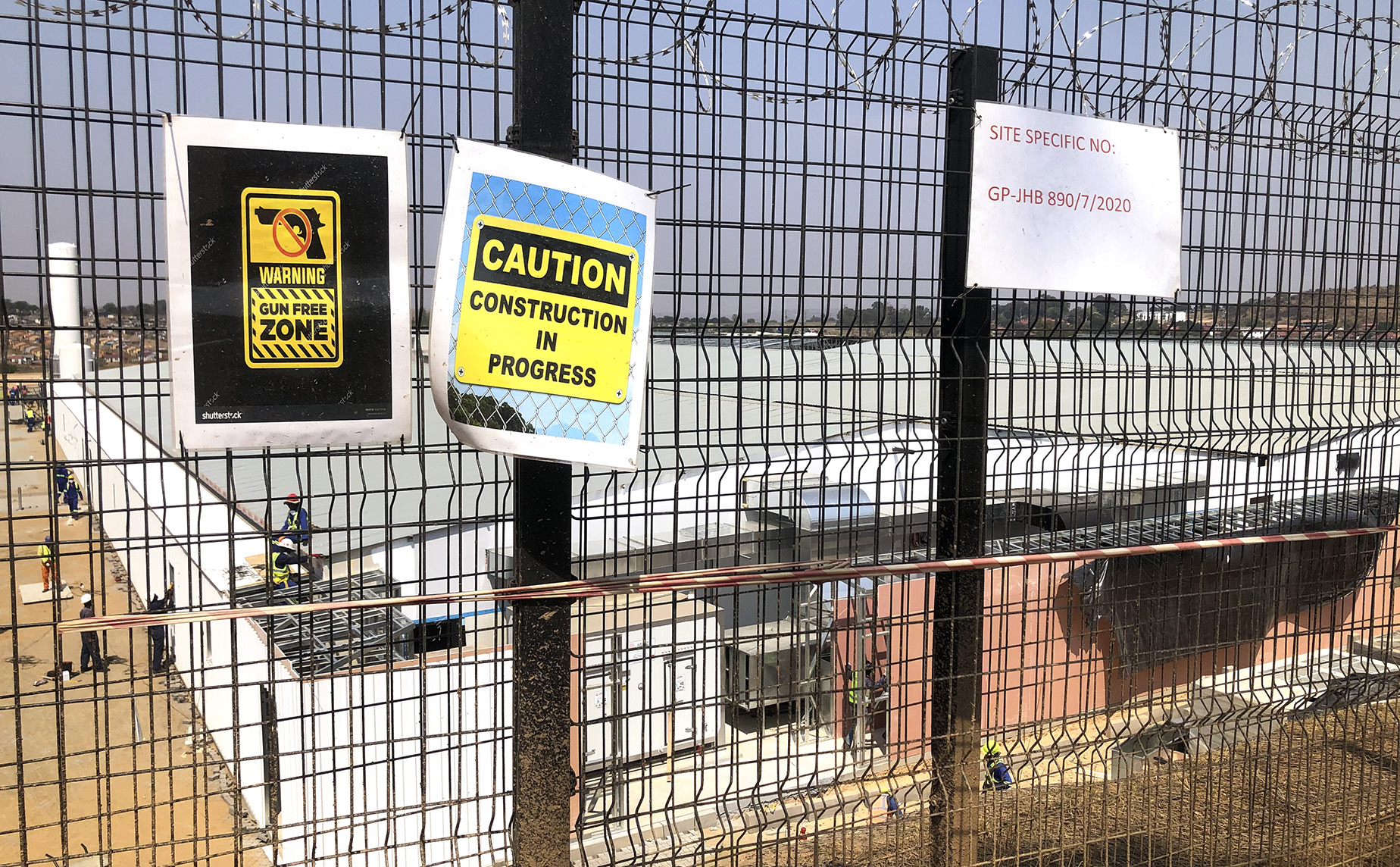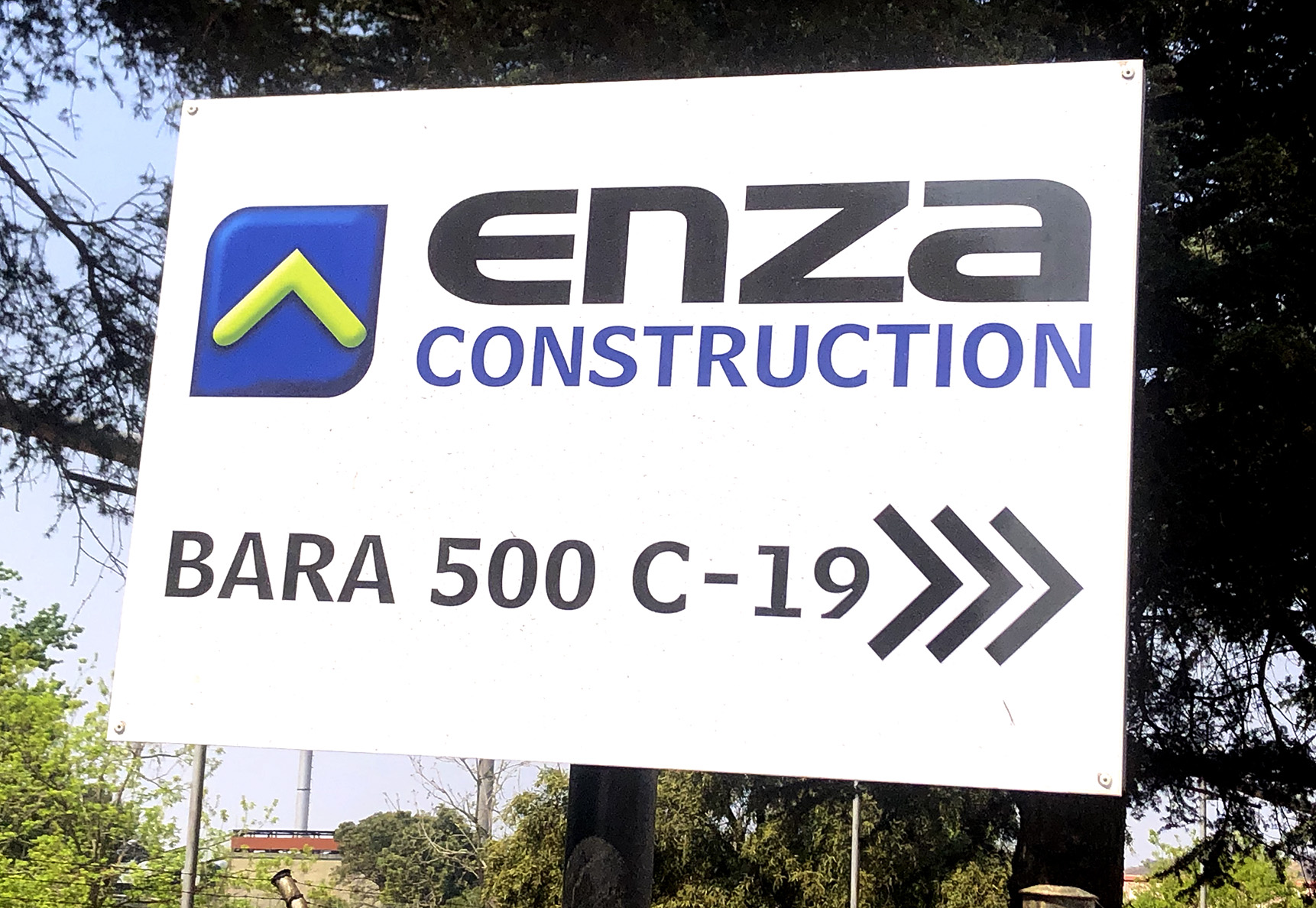Maverick Citizen Investigation
Big questions loom over Gauteng’s billion-rand ICU field hospitals

The Gauteng government has spent hundreds of millions of rands on ‘barrack-style field hospitals’ in anticipation of a Covid-19 surge which has already passed, with most of these nowhere near close to completion. Doctors say these structures were also not fit for purpose and warned billions more could be wasted. This suggests the construction of 1,400 additional ICU beds, a signature project of the provincial health department may turn out to be the biggest misspending of emergency health funds that has yet bedevilled the pandemic response.
In May 2020, in preparation for the anticipated high demand for ICU beds, the Gauteng government decided to expand its healthcare facilities by building a number of field hospitals to care for those with Covid-19. The province embarked on a programme that sought to increase its ICU bed capacity through the refurbishment of some existing facilities, as well as the building of four ICU field wards.
Despite commendable efforts to increase health infrastructure, a Maverick Citizen investigation reveals that the Gauteng government has spent nearly R200-million so far on “barrack-style field hospitals” that some experts believe are not fit for purpose, and worryingly are nowhere near complete despite the province passing its Covid-19 peak.

Alternative Building Technology (ABT).
(Photo: Mark Heywood)
Out of a total provincial allocation of R5,9-billion for the fight against Covid-19, nearly R3-billion was allocated to hospital refurbishment and construction. Then, to expedite the building process the government opted to construct the new ICU facilities using what is known in the construction industry as alternative building technology (ABT).
Asked to explain this decision Kwara Kekana, spokesperson for the office of the MEC for Health in Gauteng, told us:
“In the case of ICU units to accommodate Covid-19 patients, the use of light steel frame construction allowed for significant reduction in time for construction, in comparison to the conventional building technologies. The prefabricated nature of the light steel frame building systems also allows for the reduction of on-site building operations and vehicular traffic, which improves overall safety and security for existing facilities in the area. The light steel cladded frame interiors also allow for adaptability and flexibility with future reuse, allowing for a legacy of the infrastructure beyond the Covid-19 pandemic.”
Kekana says these benefits are set out in a 2015 document developed by the national Department of Health’s Infrastructure Unit Support Systems (IUSS) project.
However, the benefits of ABT in a high-care setting seem far from being universally accepted.
Maverick Citizen learnt that from the outset the use of ABT and the construction of field ICU hospitals were hotly contested by a number of high care specialists and some hospital administrators.
Dr Nathi Mdladla, the chief intensivist at Dr George Mukhari Academic Hospital, north of Pretoria, told a meeting of the provincial war room on 30 May that the building of ABTs “is gross wasteful expenditure as the structures were most likely going to be a white elephant”.
Mdladla notes that he and other medical professionals raised concerns about the development of the ABTs and argued that no hospital in Gauteng needed the types of ICU field units that the province wanted to build.
The head of ICU at one of the other hospitals said she had “washed her hands” of the project.
Instead, the doctors suggested alternatives that would have strengthened both capacity and quality of care in existing ICU units. At George Mukhari for example, Mdladla, supported by his hospital CEO, eventually asked the builders “to repurpose two of the eight units they were going to build (52 beds) into functional modern ICU units that could be used post Covid-19”.
At the moment George Mukhari has only one 20-bed ICU serving a population of 1,7 million people from four provinces.
Nonetheless, despite opposition from medical professionals, the province steamed ahead with its plans. It commissioned 1,400 extra ICU beds: 500 at Chris Hani Baragwanath hospital in Soweto; 300 at George Mukhari; 300 at Kopanong hospital in Vereeniging; and 200 beds at Jubilee District Hospital in Hammanskraal.
Months later, despite ABT being selected for the benefit of rapid construction, Maverick Citizen has discovered that none of the four facilities is anywhere near completion.
At the end of July 2020, a progress report presented to the Health Portfolio Committee of the Gauteng legislature revealed that only a quarter of the work at three of the four identified construction sites had been completed. At that time, it was reported that only earthworks were under way at most of these hospitals.
The same report gave the “planned handover dates” now as between September and November 2020 – months after the first wave and the envisaged need for these extra ICU beds had passed.
At the time of writing, the 300 new ICU beds at the Dr George Mukhari Hospital are still a work in progress. Mdladla is skeptical that they will be ready before November, and to make things worse, he says, the extra beds are “so remote from the main hospital that you have to transport patients 300 metres through an open space to get them to the theatre”.
This week Maverick Citizen visited the construction site of the 500-bed ICU unit on the edge of Chris Hani Baragwanath Hospital, but was denied entry. According to a site manager I spoke to briefly, up to 100 ICU beds would be ready within two weeks. However, he did not know how these beds would be equipped and staffed. That does not fall under the mandate of the company, Enza Construction, which is building the hospital.
Health workers that we approached still question whether these facilities will be needed, even if there is a second wave of Covid-19.
If they are not going to be needed for the Covid-19 emergency, are they being built in a way that is capable of being repurposed to meet other health needs?
Most seem to think not.
One senior infectious diseases expert, who did not want to be identified, answered two questions:
(1) Is it useful for Covid-19?
“Absolutely not,” he said. “Covid admissions are currently at a very low level and no big second wave is expected.” At his hospital, he says, there are currently no Covid-19 patients in ICU.
(2) Could it be useful to expand ICU capacity in general?
“Extremely doubtful. It’s not that we don’t need extra ICU beds in the state sector; we do. It’s that expanding ICU/high care beds is useless if it doesn’t come with the doctors and nurses who are specialists in intensive care medicine.”
He says that the Chris Hani Baragwanath facility isn’t integrated within the main hospital, which is necessary. “Where will the patients go if they need specialised surgical procedures, or when they’re ready to be stepped down?”
A question posed to Kekana about what amount had been budgeted for medical equipment needed to supply the hospitals was not answered, although the Expenditure Disclosure Report says that R400-million has been budgeted for “Covid-19 health technology”.
On staffing, the department’s response was, “Staff will be made available. Budget is part of the additional budget given by [the] provincial treasury for additional human resources.”
Given staff shortages, and the levels of experience and training needed by high care nurses and doctors, what this means in practice is far from clear.
What is it costing?
Up to now, the focus on spending by the Gauteng Health Department has primarily been on PPE procurement. Nobody appears to have been looking closely at other areas of expenditure.
The Expenditure Disclosure Report, which was issued by the Gauteng Treasury in mid-August under the pressure of the PPE corruption outcry was a laudable attempt at transparency. It covers all expenditure in the period between April to July 2020 and highlights that “refurbishment and rehabilitation of buildings” (R351,865,160) and “upgrading and adding to buildings” (R61,616,798) came third and fifth highest respectively in overall expenditure.
Gauteng’s Covid-19 Expenditure Disclosure Report adds murk to troubled waters
A table it provides on spending on health infrastructure records the amounts allocated as part of the special adjustment budget to provide extra ICU beds at each hospital as:
- Kopanong Hospital: R220-million
- Chris Hani Baragwanath: R496-million
- George Mukhari Academic Hospital: R233-million
- Jubilee Hospital : R268-million
In total, a hefty R1,2-billion, costing taxpayers approximately R870,000 per ICU bed – before any equipment or staffing costs are added. Our enquiries showed that this is roughly on par with what it costs to build an ICU bed in the private sector, albeit using traditional building materials.
According to Kekana the builders of the four hospitals are Condocor Construction; Enza Construction; Shomang Construction; and Concor Construction. The ABT suppliers are Sanjo Technology, Prefab Sprout, Futurecon and Trumod. Between them, expenditure to date is given as R186,765,109.10 – although it is not clear how this breaks down between suppliers and construction companies.
When asked whether these costs might yet escalate, Kekana replied ambiguously that:
“The project cost escalation of the project are dependent on the uniqueness of the project. The cash flow expenditure is vastly in line with the planned budgets.”
Strangely, none of these costs or the companies are reflected in the Expenditure Disclosure Report (although nine companies that have done other aspects of hospital refurbishing, costing over R300-million by July, are). Kekana’s explanation for this is that “the ABT project started at the end of June 2020 and the first expenditure was recorded mid July 2020.”
This field hospital project appears also to have caught the attention of the Auditor-General.
On 2 September 2020 in the media release accompanying the First Special Report on the Management of the Government’s Covid-19 Initiatives, Kimi Makwetu said his “audit teams have already identified non-compliance with legislation in the processes followed” in relation to the building of field hospitals but delays in “providing us with the information and documentation requested” meant that the AG’s audit process have only just commenced.
The first wave of Covid-19 has now passed in Gauteng and, as evident from this graph contained in the latest report on weekly deaths by the South African Medical Research Council, hospitalisations and deaths are now showing a marked decline.
Preparing for a worst-case scenario is not a bad thing. However, despite projections the system ended up not being over-run in Gauteng. If it had, any extra capacity would have been important and may well have helped save some lives. The problem though is that if the surge had been much worse, most of this extra capacity would not have been ready in time. So, it would seem the planners in the Gauteng Health Department didn’t just miss the boat – there’s a danger that they are actually wasting their time, and our money, on building a ship that’s not fit for purpose.
Our investigation has merely scratched the surface and a deeper investigation is definitely necessary. In the words of Dr Mdladla “the onus is now on the government to prove that the ABT/ICU project is not what it looks like”. DM/MC






















 Become an Insider
Become an Insider
How are these companies linked to politicians and staff in the Gauteng DOH? Condocor Construction; Enza Construction; Shomang Construction; and Concor Construction. The ABT suppliers are Sanjo Technology, Prefab Sprout, Futurecon and Trumod.
I was just about to ask the same question. However, I guess we both already know the answer…
Shame. One can almost feel sorry for the ANC. They try so hard, spend so much, and achieve so little.
Don’t feel sorry for the ANC. Save your sympathy for the water-less, hungry and homeless, all of whom might have benefitted from better fiscal controls.
So the Chines built such facilities in 10 days. Gauteng government taking more than 6 months and no result yet and a waist of R1 billion rand. This shows lack of operational skills on how to delver quick projects like this. WC did a great job with there facilities in getting them ready and well used. When is the ANC going to learn that it takes good experience and certain planning and operational skills to do such projects and not a lot of heavy weight politicians to execute projects. Again another reason why people don’t want remain honest tax payers. when you get such wastage .
We should not be perplexed at the outcome of decisions by unskilled and incompetent politicians and Health department officials. Their dilapidated framework to serve the people was eroded by corruption and greed.
The best we can do now is to replace them. And where possible, get the the vultures into Orange overalls.